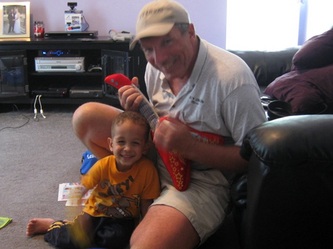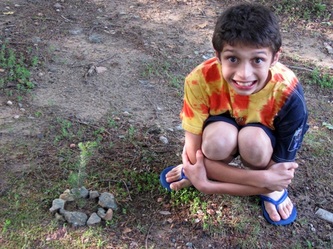
Fisherman in Cape Lookout Bight
Charleston seems like a long time ago, when in reality it hasn’t been more than a couple of weeks since we headed out for NC. Orion sits in River Dunes Marina, just north of Oriental, NC and we have already traveled north to visit the kids and grandkids, even making a brief foray into Maryland to look at a boat. We are taking some time out here in this beautiful setting, before moving on to Sarah Creek. We weren’t able to find an opening at
Joy’s Marina, so we’re instead taking a slip at York River Yacht Haven for the summer.
Joy’s Marina, so we’re instead taking a slip at York River Yacht Haven for the summer.

Dave re-fuels Orion at sea.
It’s a Motoring Trip
The trip north out of Charleston was largely uneventful, but the possibility of weather kept us alert. We pulled out of the Maritime Center at first light on the Monday after Mother’s Day, with a couple of large ships moving up the Cooper, and the tugs awaiting one of them just off the marina entrance (in preparation for spinning it to enter the docks up Town Creek). We knew this wasn’t going
to be one of our better runs. The winds were out of the northeast and not forecast to shift to more favorable southeasterly direction until the afternoon. At least we had the current with us on our way out to sea, but we knew it was likely to be a motoring trip. Our original plan to make it to Cedar Creek or the South River was scuttled Sunday night, when we belatedly looked at our log to realize we could only make that distance if we made 6.5 knots. With the wind forecast to be against us much of the first day, that was not going to happen.
After a rougher ride out the inlet (due to wind over that favorable current), we turned northeast toward Frying Pan Shoals and the waves moderated, a trend which continued throughout the day.
By early evening, we were able to motorsail a bit, but the winds were not going to last. Shortly after
midnight, the sails were furled for the night. We kept a keen ear to the weather radio. As we were leaving the Charleston harbor, we began to hear warnings of severe storms passing through Tuesday afternoon. We would be far away by then, but we weren’t sure how far north the warnings went. The “slight” chance of thunderstorms in the NOAA forecasts didn’t sound quite the same as “strong winds and damaging hail”in the verbal weather warnings. We had some bailouts planned, and decided to make a decision once we had rounded Frying Pan Shoals. If the weather seemed
doubtful, we would turn in at WrightsvilleBeach. If not, we would continue on to Cape Lookout. The night was pretty quiet, since our route was pretty far from the shipping lanes. Just before dawn we rounded Frying Pan shoals and started doing another check of the weather. We were far enough out that it was hard to get the forecast north of us, but what we could hear indicated the severe storm warnings extended north to the NC-SC border. There were no thunderstorms in the forecast for Cape Lookout. We did the math and we could get into Cape Lookout during daylight hours, so we motored on. The sails came out a few times during the day, but the wind remained light and variable. NOAA got that part of its forecast on the money.
By evening, we were anchored at Cape Lookout Bight. It was a peaceful evening, with lots of local fisherman enjoying the weather to troll the waters in the Bight. We dropped the hook around 6pm with only a couple of other sailboats in the large anchorage. Although our night was peaceful, that couldn’t be said for the waters south of us. The NOAA weather alarm went off repeatedly with warnings for the Cape Fear to Surf City region, including a specific warning for Wrightsville Beach. We were glad we had decided to keep going, even if it meant more time motoring and less
sailing.
Wednesday morning the front had passed and the winds were kicking up from the northeast. We
had a shorter trip to River Dunes and we wanted to time the current into the Beaufort Inlet, so we had a leisurely start. Since the inlet was south of Cape Lookout, we had a great sail for the first hour of the trip, until we had to furl the sails to head into the inlet. We motored up the river and into the Adams Creek – Core Creek canal, with the current most of the way. By the time, we began to poke our nose out into the Neuse River on the other end, we were pleasantly surprised that the forecasted 15 to 20 knots of wind from the northeast had moderated to around 10 knots. We motorsailed for about an hour, before furling the sails and heading for Broad Creek. We were tied up at River Dunes shortly after 5, and it didn’t take long for us to mosey over to the “best showers on the ICW” and get cleaned up. We were far removed from anything resembling the bustling harbor of Charleston, but this location has a charm of its own, which we planned to enjoy for a
while.
The trip north out of Charleston was largely uneventful, but the possibility of weather kept us alert. We pulled out of the Maritime Center at first light on the Monday after Mother’s Day, with a couple of large ships moving up the Cooper, and the tugs awaiting one of them just off the marina entrance (in preparation for spinning it to enter the docks up Town Creek). We knew this wasn’t going
to be one of our better runs. The winds were out of the northeast and not forecast to shift to more favorable southeasterly direction until the afternoon. At least we had the current with us on our way out to sea, but we knew it was likely to be a motoring trip. Our original plan to make it to Cedar Creek or the South River was scuttled Sunday night, when we belatedly looked at our log to realize we could only make that distance if we made 6.5 knots. With the wind forecast to be against us much of the first day, that was not going to happen.
After a rougher ride out the inlet (due to wind over that favorable current), we turned northeast toward Frying Pan Shoals and the waves moderated, a trend which continued throughout the day.
By early evening, we were able to motorsail a bit, but the winds were not going to last. Shortly after
midnight, the sails were furled for the night. We kept a keen ear to the weather radio. As we were leaving the Charleston harbor, we began to hear warnings of severe storms passing through Tuesday afternoon. We would be far away by then, but we weren’t sure how far north the warnings went. The “slight” chance of thunderstorms in the NOAA forecasts didn’t sound quite the same as “strong winds and damaging hail”in the verbal weather warnings. We had some bailouts planned, and decided to make a decision once we had rounded Frying Pan Shoals. If the weather seemed
doubtful, we would turn in at WrightsvilleBeach. If not, we would continue on to Cape Lookout. The night was pretty quiet, since our route was pretty far from the shipping lanes. Just before dawn we rounded Frying Pan shoals and started doing another check of the weather. We were far enough out that it was hard to get the forecast north of us, but what we could hear indicated the severe storm warnings extended north to the NC-SC border. There were no thunderstorms in the forecast for Cape Lookout. We did the math and we could get into Cape Lookout during daylight hours, so we motored on. The sails came out a few times during the day, but the wind remained light and variable. NOAA got that part of its forecast on the money.
By evening, we were anchored at Cape Lookout Bight. It was a peaceful evening, with lots of local fisherman enjoying the weather to troll the waters in the Bight. We dropped the hook around 6pm with only a couple of other sailboats in the large anchorage. Although our night was peaceful, that couldn’t be said for the waters south of us. The NOAA weather alarm went off repeatedly with warnings for the Cape Fear to Surf City region, including a specific warning for Wrightsville Beach. We were glad we had decided to keep going, even if it meant more time motoring and less
sailing.
Wednesday morning the front had passed and the winds were kicking up from the northeast. We
had a shorter trip to River Dunes and we wanted to time the current into the Beaufort Inlet, so we had a leisurely start. Since the inlet was south of Cape Lookout, we had a great sail for the first hour of the trip, until we had to furl the sails to head into the inlet. We motored up the river and into the Adams Creek – Core Creek canal, with the current most of the way. By the time, we began to poke our nose out into the Neuse River on the other end, we were pleasantly surprised that the forecasted 15 to 20 knots of wind from the northeast had moderated to around 10 knots. We motorsailed for about an hour, before furling the sails and heading for Broad Creek. We were tied up at River Dunes shortly after 5, and it didn’t take long for us to mosey over to the “best showers on the ICW” and get cleaned up. We were far removed from anything resembling the bustling harbor of Charleston, but this location has a charm of its own, which we planned to enjoy for a
while.
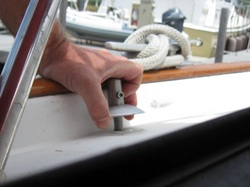
Dave re-installs the stanchion base
Where’s that water coming from?
While preparing dinner at sea on Monday night, Cathy knelt down to pull a can from under the floor boards, only to find there was water beneath three of the galley floor boards. Given the bouncy ride out of Charlestonand the heel of the boat as we motorsailed, it was a little difficult to trace the water back to its source. She cleaned up what she could find and continued on with dinner, turning off the fresh water pump breaker in case there was a leak we hadn’t seen before. The next morning, she investigated a little further and found more water
under the boards that she had missed in the dark the night before, apparently it had collected in the section closest to the Main Saloon. After soaking this up and drying out the cans that had been sitting in it, she again thought she was done. However, when we arrived at Cape Lookout, she reached for a DVD to play for the evening and discovered that many of the items on the port ledge in the Main Saloon were wet. That’s when it became obvious where the water was likely coming from. But first, let’s go back to the beginning.
While preparing dinner at sea on Monday night, Cathy knelt down to pull a can from under the floor boards, only to find there was water beneath three of the galley floor boards. Given the bouncy ride out of Charlestonand the heel of the boat as we motorsailed, it was a little difficult to trace the water back to its source. She cleaned up what she could find and continued on with dinner, turning off the fresh water pump breaker in case there was a leak we hadn’t seen before. The next morning, she investigated a little further and found more water
under the boards that she had missed in the dark the night before, apparently it had collected in the section closest to the Main Saloon. After soaking this up and drying out the cans that had been sitting in it, she again thought she was done. However, when we arrived at Cape Lookout, she reached for a DVD to play for the evening and discovered that many of the items on the port ledge in the Main Saloon were wet. That’s when it became obvious where the water was likely coming from. But first, let’s go back to the beginning.
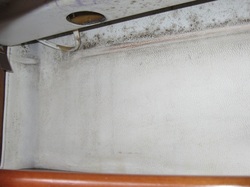
With the cabinet top removed, the stanchion base can be accessed.
It’s February of 2008 and Orion
and Slow Dancin’ are coming back
to Marathon from a weekend anchoring trip in Bahia Honda,
when Dave discovers a problem with the engine’s raw water strainer.
We decide to raft to Slow Dancin’
so that Rusty can help Dave
diagnose the problem. This turns
out to be a bad idea, because the swells – gentle as they are – rock the boats together and bend our stanchion mid-way down the port side. It was easy to order and install a replacement and Orion is good as new in a week. Tiime passes, and on some occasions, we notice that some items in the port cabinet in the Main Saloon (that happens to sit directly below this stanchion) are sometimes wet. Or some papers
stored above the locker are wet. These instances are so infrequent that we find other likely sources of the water: condensation from air conditioning vents or from the cold temperatures during our fall migration south. This year In Marathon, after a particularly nasty rainfall, we see the water again, and we can’t blame it on either of these problems. So, we put a paper towel on top of the locker and watch it. Time passes. It’s always dry. It wasn’t until the passage from Charleston that the paper towel is wet – soaking wet. In addition to the normal action from the waves on the trip, we now have our Portabote attached to the port lifelines. The combination of the original injury and the pressure of the Portabote, continued to loosen the seal and cause the water, which was running down the deck with each wave we plowed into, to seep into the boat.
and Slow Dancin’ are coming back
to Marathon from a weekend anchoring trip in Bahia Honda,
when Dave discovers a problem with the engine’s raw water strainer.
We decide to raft to Slow Dancin’
so that Rusty can help Dave
diagnose the problem. This turns
out to be a bad idea, because the swells – gentle as they are – rock the boats together and bend our stanchion mid-way down the port side. It was easy to order and install a replacement and Orion is good as new in a week. Tiime passes, and on some occasions, we notice that some items in the port cabinet in the Main Saloon (that happens to sit directly below this stanchion) are sometimes wet. Or some papers
stored above the locker are wet. These instances are so infrequent that we find other likely sources of the water: condensation from air conditioning vents or from the cold temperatures during our fall migration south. This year In Marathon, after a particularly nasty rainfall, we see the water again, and we can’t blame it on either of these problems. So, we put a paper towel on top of the locker and watch it. Time passes. It’s always dry. It wasn’t until the passage from Charleston that the paper towel is wet – soaking wet. In addition to the normal action from the waves on the trip, we now have our Portabote attached to the port lifelines. The combination of the original injury and the pressure of the Portabote, continued to loosen the seal and cause the water, which was running down the deck with each wave we plowed into, to seep into the boat.
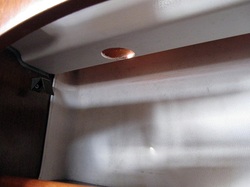
Port cabinet after cleaning
So, once we got to River Dunes we had time to address the problem. Cathy emptied the port cabinet and Dave removed its wooden top. Once he pulled out the plastic plug that gave access to the base of the stanchion, he poured water out of it, confirming our suspicion that this was the source of the problem. Since the hole was all fiberglass it took little time to dry out, although we gave it several hours. Then Dave coated the threads with Lanacote because of the dissimilar metals in the stanchion base and the nut. He next coated the
hole with Boat Life Life Caulk and screwed the nut back onto the base, just a little less than fully tight. We ran water over the deck and had no leaks. Since the Life Caulk takes about a week to cure, we left the cabinet open until it had hardened, then Dave tightened it the rest of way. We tested it with water again (thanks to a downpour that Mother Nature provided) and it was still dry. Success. Since Cathy had taken advantage of the improved access to clean the mildew off the surfaces that
were affected by the leak, it was time to put everything back together.
As with all repairs of this sort, we keep our fingers crossed, but it should be good as new (and maybe better). Only time will tell.
hole with Boat Life Life Caulk and screwed the nut back onto the base, just a little less than fully tight. We ran water over the deck and had no leaks. Since the Life Caulk takes about a week to cure, we left the cabinet open until it had hardened, then Dave tightened it the rest of way. We tested it with water again (thanks to a downpour that Mother Nature provided) and it was still dry. Success. Since Cathy had taken advantage of the improved access to clean the mildew off the surfaces that
were affected by the leak, it was time to put everything back together.
As with all repairs of this sort, we keep our fingers crossed, but it should be good as new (and maybe better). Only time will tell.

Our new boat, a Columbia T26
Our New Old Boat
As we’ve mentioned before, we are in the process are switching to a new (to us), smaller boat. After pursuing a number of different possibilities, we finally decided on a Columbia T26, based on a recommendation from Tom and Cathie from Interlude (who are currently traveling on Slow
Dancin’, but more about that later). That was part of the reason for our trip north when we got to NC. The one in question was in Mayo MD. After talking to the broker, we decided it was worth it to look at it. We drove up to see it and, sure enough, it was pretty much as advertised (unlike a number of the ones we had been looking at earlier). It had the 6 ft headroom that Dave required. It was clean and in reasonable shape. The outboard motor was in very good shape and the price was right. We made an offer that was accepted. In a couple of weeks, we’ll head back up to finalize the transfer. We’ll have a number of projects to do to make her ready to move, but we’re thinking that we can get her back to a slip near Orion by the end of July.
As we’ve mentioned before, we are in the process are switching to a new (to us), smaller boat. After pursuing a number of different possibilities, we finally decided on a Columbia T26, based on a recommendation from Tom and Cathie from Interlude (who are currently traveling on Slow
Dancin’, but more about that later). That was part of the reason for our trip north when we got to NC. The one in question was in Mayo MD. After talking to the broker, we decided it was worth it to look at it. We drove up to see it and, sure enough, it was pretty much as advertised (unlike a number of the ones we had been looking at earlier). It had the 6 ft headroom that Dave required. It was clean and in reasonable shape. The outboard motor was in very good shape and the price was right. We made an offer that was accepted. In a couple of weeks, we’ll head back up to finalize the transfer. We’ll have a number of projects to do to make her ready to move, but we’re thinking that we can get her back to a slip near Orion by the end of July.
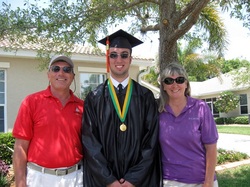
Friends and Family
We started the month with a trip to Floridato see our nephew graduate from college. It was a quick trip down and back before heading out of Charleston for NC. Once in Oriental, we took a car north and spent some time first with our daughter’s family and then with our son’s family for his birthday. We even got to take Jayden, our 4-year old grandson on a short road trip.
We started the month with a trip to Floridato see our nephew graduate from college. It was a quick trip down and back before heading out of Charleston for NC. Once in Oriental, we took a car north and spent some time first with our daughter’s family and then with our son’s family for his birthday. We even got to take Jayden, our 4-year old grandson on a short road trip.
We were pleased to see a familiar boat, Slow Dancin’, docked next to us in Charleston when
we returned from our trip to Florida. However, the crew was Tom and Cathie from Interlude, who were helping out Joy and Rusty by moving the boat back to the Chesapeake. We were able to
spend an evening together in Charleston with them and their friends, Diane and Richard on Ava Ryan. The same scenario repeated itself a week later, when they pulled into River Dunes beside us. This time we got to help surprise Cathie with a cake for her birthday. We also met another Tom and Kathy at River Dunes who were on Tenaceous, heading back to NY. We shared a trip into Oriental in the courtesy car and some time in the evening with some delicious local shrimp. They watched our boat while we took our road trip north, but had to move on before we returned.
we returned from our trip to Florida. However, the crew was Tom and Cathie from Interlude, who were helping out Joy and Rusty by moving the boat back to the Chesapeake. We were able to
spend an evening together in Charleston with them and their friends, Diane and Richard on Ava Ryan. The same scenario repeated itself a week later, when they pulled into River Dunes beside us. This time we got to help surprise Cathie with a cake for her birthday. We also met another Tom and Kathy at River Dunes who were on Tenaceous, heading back to NY. We shared a trip into Oriental in the courtesy car and some time in the evening with some delicious local shrimp. They watched our boat while we took our road trip north, but had to move on before we returned.

Dave with Cherylle at the WRCC picnic
Our arrival in Oriental was just a few days before the Waterway Radio Cruising Club Rendezvous in New Bern. We managed to rent a car for the trip
north in time to take in the picnic. We got to meet a number of people behind the call signs on the net, in
addition to seeing some old friends, Skip and Cherylle who live in New Bern.
On to the Chesapeake
We will be moving on later this week from River Dunes, but it will be hard to tear ourselves away.
With a pool, fitness center, a beautiful clubhouse and “the best showers”, not to mention a terrific staff, we have enjoyed our stay, but it’s time to get Orion settled and begin our summer projects.
north in time to take in the picnic. We got to meet a number of people behind the call signs on the net, in
addition to seeing some old friends, Skip and Cherylle who live in New Bern.
On to the Chesapeake
We will be moving on later this week from River Dunes, but it will be hard to tear ourselves away.
With a pool, fitness center, a beautiful clubhouse and “the best showers”, not to mention a terrific staff, we have enjoyed our stay, but it’s time to get Orion settled and begin our summer projects.
